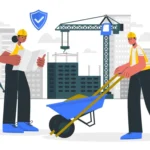In 2025, ensuring the safety of employees working alone is a part of operational continuity, reputation, and ethics. Whether it’s a construction site surveyor on a solo shift or a home healthcare nurse visiting patients in remote neighbourhoods, lone workers face daily risks without backup or supervision.
Field service businesses in industries like construction, healthcare, utilities, and property maintenance rely heavily on lone or remote workers. Safeguarding them through a reliable and intelligent lone worker safety app should be a part of every business’ workflow.

Why Workplace Safety Demands a Lone Worker Strategy
Field teams in industries like construction, home healthcare, facilities, utilities, and property management rely on employees who operate alone for part or all of their shifts. These lone workers face elevated risks because:
- There’s no one nearby to assist in case of injury or medical emergency
- Confrontations with the public can escalate quickly
- Harsh environments and physical strain can trigger falls or health events
- Help may be delayed or unavailable in rural or hazardous zones
According to OSHA, it is every employer’s responsibility to provide a safe and healthful workplace. For lone workers, that means more than handing out PPE or offering a helpline. It requires a proactive, technology-first approach to real-time monitoring, communication, and emergency response
The Problem with Outdated Safety Protocols
Many businesses still rely on phone-based check-ins or manual logs. But these systems:
- Can’t detect if someone is unconscious or immobile
- Don’t provide real-time GPS location
- Lack automated escalation workflows
- Often fail to meet OSHA or local safety regulations
A working alone check in app offers far more advanced protection. But not just any app will do.

Step 1: Identify Lone Workers in Your Organization
Not every lone worker is stationed at a remote site. Many work in populated areas, but still face periods of isolation. Start by identifying workers who:
- Perform tasks alone without direct supervision
- Visit multiple sites, such as caregivers, inspectors, or sales reps
- Work night shifts or off-hours, like retail managers or cleaning staff
- Operate in industrial environments alone, like factory technicians or utility operators
Knowing who your lone workers are is the first step toward building an effective safety strategy.
Step 2: Conduct a Formal Lone Worker Risk Assessment
Once identified, assess the specific risks each role encounters.
Typical risks include:
- Environmental: slips, falls, extreme weather, chemical exposure
- Medical: asthma attacks, heart conditions, or fainting without assistance
- Behavioral: violence, harassment, or aggression during field visits
- Equipment: working alone with heavy machinery or confined space risks
allGeo supports digital safety assessments and customizable forms, making it easy to document risk factors and assign mitigation plans by role or site.
Step 3: Create and Document a Lone Worker Safety Policy
Your policy should clearly outline how you protect lone workers and what actions are taken during emergencies. It should include:
- Definition of lone work within your organization
- Role-specific risk assessments and mitigation steps
- Standard procedures for using safety devices or mobile apps
- Check-in frequency and emergency escalation workflows
- Roles and responsibilities of workers and supervisors
- Training requirements and review schedules
Step 4: Select the Right Lone Worker Safety Technology
Not all lone worker tools are created equal. Your technology should meet real-world demands and situations like poor connectivity, changing locations, and rapid emergency response.
Key features to prioritize:
- Mobile app with multi-mode check-ins: app, IVR, SMS, offline forms
- Man-down detection or motion alerts for immobility incidents
- GPS breadcrumb trails
- SOS activation
Unlike off-the-shelf apps or hardware-bound panic buttons, allGeo offers a flexible, integrated solution designed for the complexities of field operations.
Step 5: Train, Test, and Continuously Improve
A safety strategy is only as good as its execution. Equip your team with training and tools they’ll actually use and trust.
- Provide onboarding and regular refreshers on how to use lone worker tools
- Run mock emergencies to test response times and escalation workflows
- Encourage workers to report near misses and suggestions for improvements
- Review incident data to update safety policies as environments evolve
Why allGeo is the Field-Proven Lone Worker Safety Platform
Trusted by field teams across healthcare, utilities, construction, and facilities management, allGeo goes beyond basic check-ins.
allGeo: Safety Built for the Field
That’s where allGeo’s Lone Worker Safety App stands out. It’s specifically designed for the complex, high-risk nature of field work. The app offers features like:
- SOS Panic Button: Activated with a simple four-tap gesture of the phone’s power button
- GPS Tracking: Supervisors can see where each lone worker is in real time
- Automated Safety Check-ins: Custom countdown timers ensure consistent worker updates, without manual effort
- IVR, SMS, and Offline Modes: Critical for remote worker safety in areas with weak mobile signals
- Compliance Logging and Reporting: OSHA-ready records to demonstrate duty-of-care and reduce liability
Use Case: Field Safety in Action
A telecom technician checks in before starting maintenance on a remote cell tower. Mid-task, he suffers a fall and loses consciousness. Because the worker misses his next check-in, allGeo auto-escalates the alert. A supervisor receives the notification and views his last known GPS coordinates. Emergency services are dispatched immediately, with a full log captured for compliance and follow-up review.
This is what a modern lone worker strategy looks like in motion- fast, automatic, and life-saving.
Final Thoughts: Don’t Let Your Safety Plan End at the Policy
Improving safety at work is not about adding another form or training session. It’s about giving workers real protection, backed by smart technology, clear procedures, and responsive support.
With allGeo, your team gains confidence in the field, your supervisors gain visibility, and your organization gains a competitive edge in safety compliance and worker satisfaction.
Start protecting your lone workers today with allGeo
👉Start your free trial
👉Request a personalized demo for your industry


